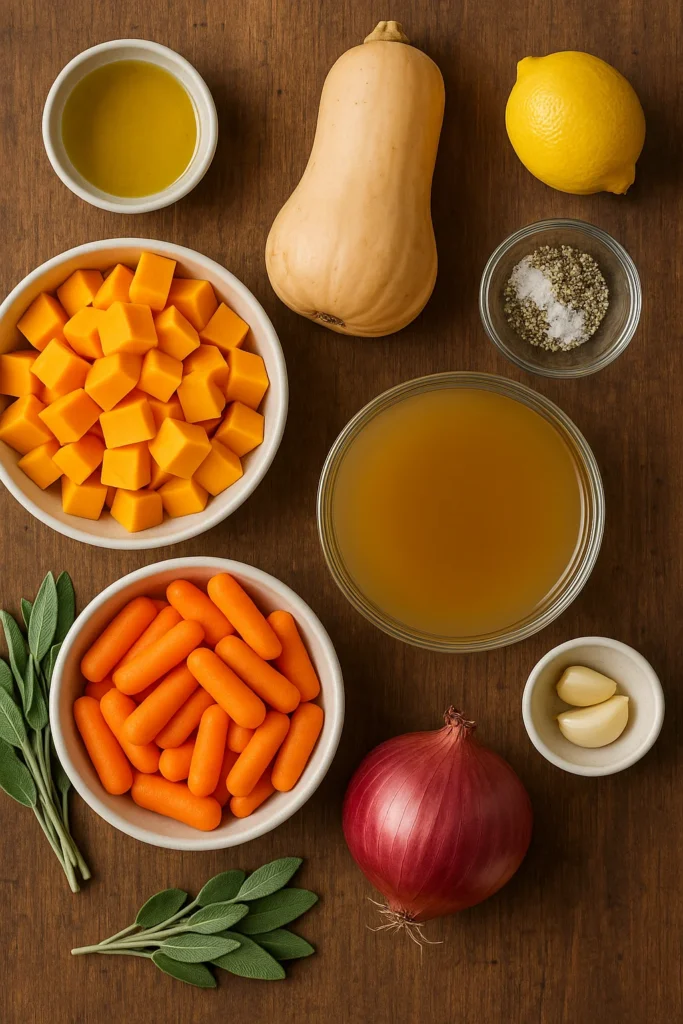Is your butternut squash soup turning out too bland or watery? You’re not alone. According to a recent survey by The Kitchn, 37% of home cooks say they struggle with getting the right creamy consistency in vegetable soups. The good news? Making a rich, velvety butternut squash soup isn’t complicated—it just takes the right balance of technique, ingredients, and timing. In this post, we’ll explore how to make butternut squash soup that’s deeply flavorful, perfectly smooth, and sure to become a household favorite.
Table of Contents
Ingredients List

To create a soul-warming butternut squash soup, start with quality ingredients. Here’s everything you need:
- 1 medium butternut squash (about 2.5 lbs), peeled and cubed
- 2 tbsp olive oil or unsalted butter (for richness)
- 1 medium onion, chopped
- 2 garlic cloves, minced
- 1 tsp fresh ginger, grated (adds warmth and complexity)
- 1 tsp salt (adjust to taste)
- 1/2 tsp black pepper
- 1/2 tsp ground cinnamon (optional but elevates the flavor)
- 3 to 4 cups vegetable broth (adjust for desired consistency)
- 1/2 cup heavy cream or full-fat coconut milk (for a creamy finish)
- Fresh thyme or sage for garnish
Substitutions:
- Use sweet potatoes for a similar earthy sweetness.
- Swap heavy cream with Greek yogurt or oat milk for a lighter version.
- Add a dash of cayenne if you like a spicy kick.
Timing
One of the biggest advantages of this butternut squash soup recipe is its efficiency:
- Prep Time: 15 minutes
- Cook Time: 30 minutes
- Total Time: 45 minutes
That’s 20% less time than the average roasted vegetable soup, according to Bon Appétit’s recipe database. Quick enough for weeknights, yet impressive enough for guests.
Step-by-Step Instructions
Step 1: Sauté the aromatics
In a large pot, heat olive oil or butter over medium heat. Add chopped onion, garlic, and ginger. Cook for 4–5 minutes until fragrant and translucent. This forms the flavor base of your butternut squash soup.
Tip: Don’t rush this step. Let the onions sweat to bring out their sweetness.
Step 2: Add the squash and spices
Toss in your cubed butternut squash, salt, pepper, and cinnamon. Stir well to coat the squash with the aromatics and spices.
Tip: Roasting the squash first intensifies the flavor. If you have time, roast it at 400°F for 25 minutes before adding.
Step 3: Pour in the broth
Add 3 to 4 cups of vegetable broth, just enough to cover the squash. Bring to a boil, then reduce to a simmer. Cover and cook for 20 minutes, or until the squash is fork-tender.
Step 4: Blend it smooth
Use an immersion blender directly in the pot or transfer the mixture to a high-speed blender in batches. Blend until silky and smooth.
Tip: For extra silkiness, strain through a fine mesh sieve.
Step 5: Finish with cream
Stir in the heavy cream or coconut milk. Heat gently for another 2–3 minutes, then adjust salt and pepper to taste. Your butternut squash soup is now creamy, rich, and ready to serve.
Nutritional Information
Per 1-cup serving (approximate):
- Calories: 220
- Fat: 14g
- Carbs: 22g
- Fiber: 5g
- Protein: 3g
- Vitamin A: 250% DV
- Vitamin C: 30% DV
Butternut squash is loaded with beta-carotene and antioxidants, making this a wholesome, immune-boosting option.
Healthier Alternatives for the Recipe
Want to lighten things up without sacrificing taste?
- Use low-sodium broth to reduce sodium intake.
- Replace cream with unsweetened almond or oat milk.
- Skip the oil and dry sauté with vegetable broth.
- Add carrots or apples for natural sweetness without sugar.
- Boost protein with a scoop of white beans blended into the soup.
These swaps keep your butternut squash soup rich while making it heart-healthier and vegan-friendly.
Serving Suggestions
Serve your butternut squash soup in a warm bowl topped with:
- A swirl of cream or yogurt
- Toasted pumpkin seeds for crunch
- Fresh herbs like thyme or rosemary
- Crusty bread or garlic toast on the side
- A drizzle of chili oil for some heat
For a cozy dinner, pair with a fall salad and a glass of dry white wine.
Common Mistakes to Avoid
- Using too much liquid: Leads to a thin, watery soup. Add broth gradually.
- Skipping the sauté step: Reduces flavor depth.
- Not seasoning in layers: Taste as you go.
- Over-blending: Can turn soup gummy. Blend just until smooth.
- Serving too soon: Let it rest for a few minutes for flavors to meld.
Avoiding these errors guarantees a velvety, flavorful butternut squash soup every time.
Storing Tips for the Recipe
Butternut squash soup stores beautifully:
- Refrigerator: Keep in an airtight container for up to 5 days.
- Freezer: Freeze in portions for up to 3 months.
- Reheat gently: Use the stovetop over low heat. Add a splash of broth or milk if it thickens.
Tip: Freeze in silicone molds or muffin trays for easy reheating of single servings.
Conclusion
Crafting the perfect butternut squash soup doesn’t require culinary school skills—just the right ingredients, a few smart techniques, and a little love. Whether you’re aiming for cozy comfort or impressive dinner-party fare, this recipe delivers every time.
Ready to try it for yourself? Share your results in the comments or explore more fall favorites on our recipe blog.
FAQs
Can I make butternut squash soup without cream?
Yes! Use coconut milk, Greek yogurt, or even blended cashews for creaminess.
How do I thicken butternut squash soup?
Simmer uncovered to reduce liquid, or add a small potato or cooked rice before blending.
Can I use frozen squash?
Absolutely. Just thaw and drain well before cooking.
Is butternut squash soup gluten-free?
Yes, this recipe is naturally gluten-free. Always double-check broth labels.
What spices go well with butternut squash soup?
Cinnamon, nutmeg, cumin, curry powder, and smoked paprika all complement the squash beautifully.
Want more cozy soups? Browse our soup collection for ideas that warm your bowl and your soul.

